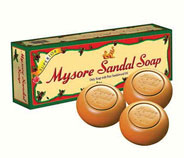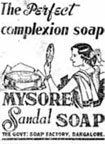
The state-owned Karnataka Soaps and Detergents Limited (KSDL) that manufactures the iconic Mysore Sandal Soap, has been a household staple for generations. It truly embodies the Make in India concept in its essence. And to think, it started exactly a 100 years ago...
Hey, that’s the understatement of the year. The product just completed a century of its delectable existence—achieving more than what it set out to do: create an iconic product that would give due justice to its Indian heritage.
Replete with aromatic essential oil which is extracted through an elaborate process of distillation from the legendary sandalwood tree—one of the mainstays of the Indian beauty and medical industry, to say nothing of the much-revered indigenous science Ayurveda, the soap still does not have a worthy competitor despite the advent of time—as proved by its turnover. While, it has long crossed the Rs.100 crore turnover landmark in 2003, the near-latest figures indicate sales to be in the realm of Rs.350 crore approximately.
It all started in the May of 1916 when Nalwadi Krishna Raj Wodeyar, Maharaja of Mysore and his Diwan M Visvesvaraya, two enterprising and culturally proud beings, set up the Government Sandalwood Oil Factory in Mysore to extract sandalwood oil from sandalwood.
The seeds of this brave endeavour had been sown two years ago, when the Maharaja was gifted a casket of soaps made using sandalwood oil produced in India. While he enjoyed using the product, the Maharaja mulled over the sheer irony of using—of all the things—an imported sandalwood soap! ‘Why can we not make our own and get noticed for a produce that has been our own for thousands of years?,’ he thought.
It was also perfectly in sync with the profile of the kingdom. The Kingdom of Mysore was one of the largest producers and exporters of sandalwood in the world. However, during the economic recession caused by the First World War in Europe, buying sandalwood was no more a priority with that war-torn region. Making a soap out of these surplus trees would be the perfect way to utilise the surplus.
SG Shastry, a noted industrial chemist of the time, was asked to develop the sandalwood perfume—which he did with considerable success, staying true to its sweet and woody notes. And thus was established the Government factory in Bangalore (Bengaluru)—giving pride of place to sandal soap with sandal notes as its base fragrance.
Even so, it took about two years for the Mysore Sandal Soap brand to hit the market in 1918. With sandal notes as its foundation, the soap also had other natural essential oils like Vetivert, Patchouli, Geranium, Palm Rosa, orange and Petitgrain.
The product found slow but steady acceptance as a ‘pure’ and ‘top-quality’ soap that actually made a difference to the skin of the user. Gradually, the toilet soap production capacity was enhanced to 750 MT/annum, while the second sandalwood oil extraction plant was started in 1944. By 1965, the soap was being exported to various countries.
In 1980, the Government Soap Factory was converted into a public sector enterprise. The company was incorporated in July 1980 and renamed as Karnataka Soaps and Detergents Limited (KSDL). KSDL has manufacturing units at Bengaluru, Mysuru and Shimoga and produces a host of commodities including soaps, detergents, incense sticks and cosmetics. Sharabha, a mythical creature with a body of a lion and the head of an elephant, was chosen as the logo of the company. This was because the creature represents the combined virtues of wisdom, courage and strength and symbolises the company’s philosophy. As of today, the company makes and sells a variety of sandalwood soaps to reach out to as many users as possible.
This includes the special edition that costs Rs.720 for a 150-gm bar, a baby sandal soap specially designed for the tender skin of infants, as well as the super-exotic rose-sandalwood soap, to name just a few.
In 1980, the Government soap factory was converted into a public sector enterprise. The company was incorporated in July 1980 and renamed as KSDL

Apart from being a non-sticky antiseptic that helps heal wounds and irritated skin, sandalwood soothes and cools inflamed skin. This means it is perfect for most people, irrespective of their age and stage in life. It is also an effective antispasmodic that is frequently employed by Ayurveda. An essential in most women’s beauty regimes, it forms a fragrant base for most face packs.
So when all of this is whittled down in a soap—leaving you free of the hassle of rubbing the sandalwood stick on a wet stone surface, all the better to get its first extract—it is welcome for more reasons than one.
To further add to its trustworthy persona, in 2006, Mysore Sandal Soap got the coveted Geographical Indications (GI) tag, attesting to its high quality.
Around the same time, the cricketing star Mahendra Singh Dhoni, the first-ever popular figure to promote Mysore Sandal Soap, became the brand ambassador for the soap.
Just like the soap, Dhoni was gratifyingly desi, real and undoubtedly, stellar. Both the ambassador and the product seemed to be a perfect fit.
But the partnership was not to be. Soon relations soured irrevocably with the company accusing Dhoni for “defaulting on his commercial commitments”. However, the five-year -long battle did not end well for KSDL, with the Karnataka High Court ruling in Dhoni’s favour.

For starters, there’s competition from several companies that make herbal products. Then, there’s the inescapable fact that 85 percent of the sales of this soap are from the Southern states like Karnataka, Andhra Pradesh and Tamil Nadu. This, in spite of the long-standing status enjoyed by sandalwood in Indian culture across the board.
Also, for some reason, the soap has never been seen as ‘hip and happening’ and most of the users happen to be over 40 years of age.
Most serious of all, KSDL is facing issues like shortage of sandalwood which has resulted in the company using only 25 percent of the manufacturing capacity of its factory leading to a lesser production of soaps. The main reason for this is the destruction of sandalwood trees in Karnataka.
To overcome this problem, KSDL has started procuring sandalwood by bidding in the open market and is also considering importing the wood from other countries.
Think about the irony of such a thing happening in a state that once set up factories to use up its excessive reserves.
On the bright side, though, this is a much-respected product with government backing. It has survived in the past. Experts say it can do the same in the future, by building a sustainable sandalwood regeneration programme, educating people on the merits of sandalwood, re-marketing the product for a younger demographic whilst retaining its old strength: its purity and trustworthiness.
By Kalyani Sardesai